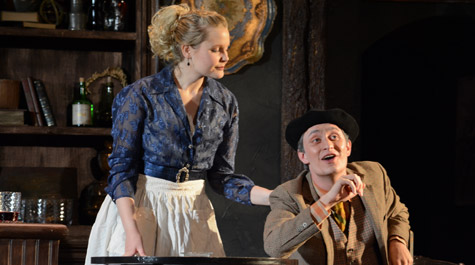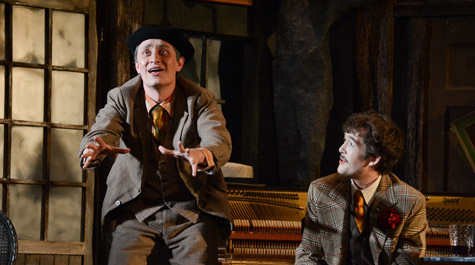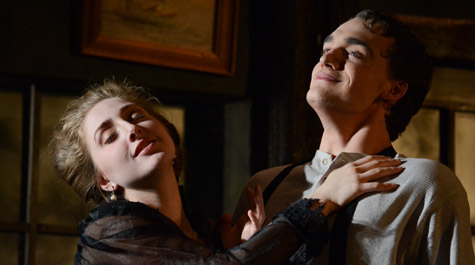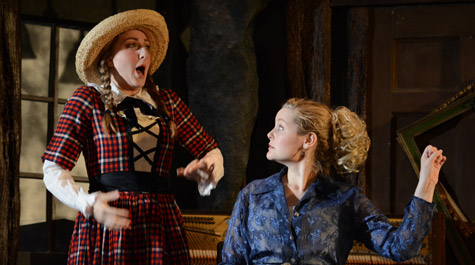‘Picasso at the Lapin Agile’ parallels COLL curriculum
Theatre cast, crew called on W&M physicist to help interpret the comedy’s science
“If someone was going to write a script specifically to highlight what could be possible with the COLL curriculum, this might literally be it,” said Matt Allar, Class of 1955 Associate Professor of Theatre.
Allar’s in a good position to say so. He’s not only the scenic designer for the new show, “Picasso at the Lapin Agile,” which opened Thursday, April 21, at William & Mary’s Phi Beta Kappa Hall, he’s also a fellow with the Center for the Liberal Arts, which has been working for two years to help develop and implement the new general education College Curriculum, or COLL.
The play, written by Steve Martin, is a comedy that puts the Spanish artist Pablo Picasso in an imaginary conversation with physicist Albert Einstein in a French bar in 1904, on the eve of their major breakthroughs. Picasso will revolutionize art with the cubist movement, while Einstein will overturn the understanding of time and space.
Meanwhile, COLL aims to put the academic disciplines in conversation with one another in the classroom, encourages students to think globally and to confront the big questions that academia seeks to answer.
“The play couldn’t be more in line with the goals of particularly COLL 200, which asks students and faculty to engage material through a home academic domain but immediately reaches out to other domains to seek different points of reference and investigations,” Allar said. “That’s very specifically, almost from the first five minutes and through the whole production, what this play is digging at.”
There’s another dimension, though. It is not just the subject matter of the play that parallels COLL, it’s how the cast and crew went about preparing for the show.
Early on, Sarah Dixon, theatre instructor and show director, reached out to friends of hers from other disciplines to help interpret both Picasso and Einstein. She found the perfect pair in Hans von Baeyer, physics professor emeritus, and Barbara Watkinson, art history professor emerita, who are married.
Because of scheduling conflicts, Dixon was not able to engage Watkinson nor Charles Palermo, associate art history professor and director of film and media studies, as much as she would have liked. (Palermo recently published Modernism and Authority: Picasso and His Milieu Around 1900).
But von Baeyer has been involved in helping translate the physics and scientific references for Dixon, dramaturge Sydney Battle ’16 and, most importantly, the show’s Einstein, Andrew Perry ’16.
“Hans was a great resource and has been throughout the whole show,” Perry said. “He gave me a great deal of valuable insight into science, Einstein and physics in general. It’s the first time I can remember two such different departments – theatre and physics – coming together to put on a show. You couldn’t even really imagine that happening.”
Dixon said von Baeyer also helped them understand a deeper theme to the comedy. Picasso and Einstein of course upended the conventions in their fields, but they also both placed subjectivity, or the individual, at the center, she said.
Picasso’s cubism considered objects and people from multiple angles, asking the viewer to mentally reassemble them to derive meaning, von Baeyer said. Einstein’s Theory of Special Relativity similarly put the observer at the center, proving that space and time do not exist independently of the observer’s condition.
“I think it’s also fair to say that the impulses from which physicists start and the impulses from which artists start are identical,” von Baeyer said. “As a physicist, I’d like to understand how that tree works. A painter would like to understand what it says to me. The starting questions about trying to make sense of the world are identical. They’re equally valid and equally honorable.”
Dixon said that in response, as a director she tried to create a sense of intimacy as the two main characters converse. “Picasso at one point says, ‘This is a night the world fell silent and listened to a conversation,’” she said. “That’s the feel I wanted with this play.”
Heady stuff, but Dixon said neither the cast nor crew lost their way from the show’s main objective: comedy.
“This is not a factual representation of Picasso and Einstein,” she said. “It’s just an idea. It’s a fun, light-hearted idea that we’re going to explore for 90 minutes.”
“Picasso at the Lapin Agile” will be performed at Phi Beta Kappa Hall at 7:30 p.m. on April 21, 22 and 23, and at 2 p.m. on April 24. Tickets can be purchased at the PBK Hall box office. For more information, visit the box office website.
 Skip to main content
Skip to main content




